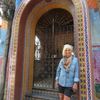
Consider heading south the end of October. While well-known all over Mexico and in many other Latin countries, Dias de Los Muertos in San Miguel is nothing short of spectacular, charming and heart-warming. The entire city transforms to a near “museum” of vibrant folkloric art, fiestas, parades and generations-old traditions, including the typical food for the evening of atole, mole and tamales. Abuelas (or grandmothers) teach daughters to craft unique colorful offering or “offirendas” of sugar in unique forms, shapes and sizes. They appear as precious miniature animals, fruits and cartoon characters – a veritable Noah’s Ark of edible delights, sold in tiendas (or markets) near the main cathedral. Families take flowers to the cemetery to pay respect to ancestors. A myriad tapestry of experiences awaits your visit.
A multi-sensory extravaganza awaits your visits “just down the road” in San Miguel de Allende. You’ll be greeted by intimacy, art/architecture and a centuries-old culture with similarities to your own.
Plus you can combine your getaway with an opportunity to learn another language through a total immersion home-stay program. Some term it a real life experience of “mi casa es tu casa” (or my house is your house …) – You can also stay right at the school.
If your destination plans include truly learning Spanish, you might consider the Instituto Habla Hispana. With the global economy, more travelers are finding that an additional language is both helpful and necessary. Whether it’s for business or the pleasure of learning, you might want to try a great escape that gives you both the experience of the culture and the language itself.
About three hours from Mexico City, The Instituto Habla Hispana offers a unique twist: you live with a Mexican family while studying. The school matches suitable Mexican homes with students.
While the curriculum is flexible, most students stay one month. The Spanish classes are a mixed bag of dialogue, informal conversation, grammar and written drills.
There is a cultural exposure with discussions about the antiquities and Mexican pyramids, Mayans and Conquistadors. There are also Spanish classes in music, singing and cooking to add variety. It’s a total immersion program but with many subjects, and patient instruction.
They feature various levels of instruction and place you in the right class for your ability. The language school holiday is a hybrid of learning the culture and history, as well as picking up Spanish through the immersion technique. At home, you’re part of the family, while at school you are taught all the basics in a classroom atmosphere of discipline combined with humor. If the level you’re assigned to is too difficult, you’ll be reassigned to meet your needs to learn. While effective, the atmosphere is relaxed. The school also provides extra outings to nearby colonial cities, markets and natural springs. The school has attracted students from around the world, with diverse backgrounds, such as businessmen, teachers, farmers, pilots and diplomats. The overall cost is about $1400 a month, which includes room and board.
Meanwhile, part of the total immersion experience is staying with a host family. For this student/travel writer the day-to-day living with the host family is part and parcel of the learning process. It mandates an overall exposure to their lifestyle. The week in their home also encourages the use of a wider vocabulary, since none of the family members speak English. The Berra Lopez host family prepared three meals a day and threw in some warm hospitality at no extra charge.
While I learned French in University, the classroom approach and home reinforcement was invaluable. Early on, I realized Maria Lopez (my Mexican mother) would help out with levity and compassion since her breakfast table has for 20 years greeted students from around the world, all stumbling merrily through Spanish together and making hundreds of grammatical and pronunciation errors. This old fourth generation ranch family offered a perspective on their rich tapestry of a culture and values which continues to this day, 15 years later, as the relationship continues, with “hands across the border”.

Mi casa es tu casa is a phrase that denotes the warm welcome you’ll feel in San Miguel!
Where to shop:
If you are seeking unique local items, don’t miss Arts and Antiques, on Relox Street. It has great prices and creative pieces small enough for your luggage.

